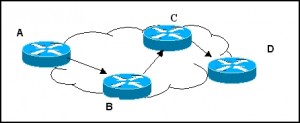
Before getting into the detail of the various Routing Protocols, lets go over some of the fundamental concepts and principles of IP Routing, starting with an explanation of Distance Vector routing protocols…..
Distance Vector Routing Protocols
- examples: RIP, IGRP, EIGRP
- a router using a DV protocol knows 2 things:
- Distance to final destination
- Vector (or direction) traffic should sent
- used in smaller environments where routes do not change often, such as a LAN’s
- do not scale well, so not suitable for WAN’s
- each DV router sends some or all of it’s routing table in updates, but only to it’s neighbours
- DV routers only know about their neighbours
- built in features for preventing routing loops:
- Split Horizon – a routing protocol will never advertise a route back out of the interface that the route was learnt on
- Poison Reverse – if a network becomes unavailable then a router will advertise that network with a metric of 16 (max is 15) , which allows other routers to quickly learn that a network is unavailable
Distance Vector Routing Protocol Comparison Table:
| RIPv1 | RIPv2 | EIGRP* | |
|---|---|---|---|
| algorithm? | Bellman-Ford | Bellman-Ford | DUAL |
| update method? | broadcast | multicast to 224.0.0.9 | multicast to 224.0.0.10 |
| update frequency? | every 30 Seconds | every 30 Seconds | when there’s a change |
| update contains? | whole routing table | whole routing table | only route changes |
| max routes per update? | 25 | 25 | n/a |
| classless? | no | yes | yes |
| equal cost load balancing? | yes, by default | yes, by default | yes, by default |
| un-equal cost load balancing? | no | no | yes, with “variance” command |
| max hop count? | 15 | 15 | 255 (100 is default) |
| authentication? | no | clear-text & MD5 | MD5 |
*note – EIGRP is not a true DV protocol but has some features of DV and is included here for comparison.
How does a Router decide which route to use?
When a router knows of multiple routes to get packets to a particular destination network, it has to decide which is the best route to use.
Here is the logic that the outer uses to make the forwarding decision:
- multiple routes = route with longest Prefix wins
- multiple routes + same prefix length = route with lowest Administrative Distance wins
- multiple routes + same prefix length + same AD = route lowest Metric wins
- multiple routes + same prefix length + same AD + same Metric = router will Load Balance
Administrative Distances
| Type Of Route | Administrative Distance |
|---|---|
| Directly Connected | 0 |
| Static (with exit interface) | 0 |
| Static (with next hop IP) | 1 |
| EIGRP Summary | 5 |
| External BGP | 20 |
| EIGRP (Internal) | 90 |
| OSPF | 110 |
| RIP | 120 |
| EIGRP (External) | 170 |
| Internal BGP | 200 |
| Unknown Network | 255 |
So that’s a bunch of the basics covered off, next post up is Static Routing…….
Cheers.
Rich
Follow me on Twitter